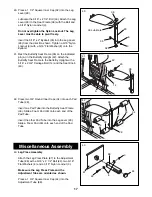
4
Note: This introduction will save you more
time than it takes to read it!
Identifying Parts
To help you identify the small parts used in assem-
bly, we have included a PART IDENTIFICATION
CHART located in the center of this manual. Place
the chart on the floor or work table and use it to
quickly identify different parts as you open the pack-
ages for each step.
Note: Some small parts may have been pre-attached
for shipping. If a part is not in the parts bag, check to
see if it has been pre-attached.
Orienting Parts
As you assemble this product, be sure that all parts
are oriented as shown in the drawings.
Tightening of Parts
Tighten all parts as you assemble them, unless
instructed to do otherwise.
Lining Up the Tools
Assembly requires the following tools (not included):
¥ Two (2) adjustable wrenches
¥ One (1) standard screwdriver
¥ One (1) phillips screwdriver
¥ One (1) rubber mallet
¥ Lubricant, such as grease or petroleum jelly,
and soapy water
¥ Tape, such as clear tape or masking tape
Assembly will be more convenient if you have a
socket set, a set of open-end or closed-end wrenches
or a set of ratchet wrenches.
Giving Yourself a Good Start
Before you begin the assembly process itself, take
the time to complete the steps outlined here.
Clearing the Workspace
Clear a workspace that is large enough to hold all
parts and allow you to walk all the way around the
assembled equipment.
Unpacking the Box
To make the assembly process as smooth as possi-
ble, we have broken it into separate stages. All parts
used in each stage are found in individual packages
in the shipping box. Place all parts in a cleared area
and remove the packing materials. Do not dispose of
the packing materials until assembly is completed.
Important: Wait until you begin each assembly
stage to open the parts bag labeled for that
assembly stage.
Assembly
Making Things Easier for Yourself
Everything in this manual is designed to ensure
that the assembly of our products can be complet-
ed successfully by anyone. However, it is impor-
tant to recognize that your new equipment is a
sophisticated product with many small parts. The
assembly process will take timeÑpossibly several
hours. Most people find that by setting aside plen-
ty of time, and by deciding to make the task
enjoyable, assembly will go smoothly. You may
want to complete the process over a couple of
evenings.
The Four Stages of the Assembly Process
Frame Assembly
You will begin by assembling the base and the
upright frames that serve as the skeleton of the
equipment. The seats and all moving parts will be
attached to the frame.
Arm Assembly
Completes the press and butterfly arms that you
operate while you are exercising.
Cable Assembly
Completes the cables and pulleys that connect the
moving arms with each other and with the weights.
This ties the different parts together and makes the
equipment function as a unit
Seat Assembly
Completes the seats and backrests that support
your body while you are exercising.





































